GAA's Guide to the C6 Lap Steel Tuning
Introduction
This page describes an approach to learning the C6 tuning for the six string lap steel. C6 is a popular tuning for electric lap steel. It's often used when playing Hawaiian and Western Swing music. From bass to treble the notes are C E G A C E.I don't claim to be an expert, but I have found this approach useful. Long ago I unsucessfully tried to learn to play the C6 tuning. I then came back to it after a few years (I'd been playing a lot of bluegrass dobro in the meantime), and used the approach I describe. Everything "fell into place".
You can actually ignore the details of this analysis and work them out on your own. The key concept is that there are three basic chord shapes and you need to learn how to navigate between them. This is similar to the CAGED system used to learn the standard guitar fretboard.
In this analysis below I talk about the I, IV and V chords. Since I'm giving concrete examples, I use the key of G. In the key of G the I, IV and V chords are G, C and D respectively.
Step 1 - The Three Basic Chord Shapes
The diagram below shows the three positions where the notes of a G chord are found. There is a straight-bar chord at the seventh fret, a "V" shaped chord at the tenth fret and a diagonal shaped chord at the fourteenth fret. The number in the circle indicates the scale degree of the note. In a G chord, G is the root or 1 note, B is the third note and D is the fifth note.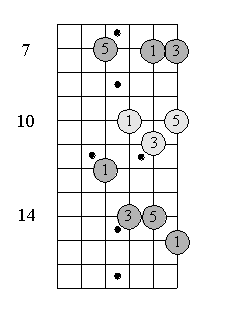
You need to memorize these three positions and the scale degree of each note in each position. You should be able to play a G scale in each of these positions.
There is a good reason for learning these positions. If a G chord is being played and you're improvising or playing a melody, the melodic line will usually be centered around the notes in the G chord. Also if you're studying the tablature for a tune you'll find that if the chord is a G then you'll be playing out of one of these three positions.
Step 2 - Navigating to the IV and V Chord
Once you learn the three basic positions for the I chord, then you need to learn to navigate from the I chord to IV and V chords. If the song goes from the G chord to the C chord it is possible play out of the straight-bar position at the seventh fret for the G chord then jump to the C chord at the twelveth fret, but it won't sound as smooth as if you stay centered around the seventh fret.There are three diagrams below, one for each of the three basic positions where a I chord is found. Each diagram shows the nearby IV and V chords relative to the I chord. Note that the chord shapes for the IV and V chords are always one of the three basic chord shapes. In some cases there are two different places where a nearby IV or V chord is found.
Every note in the diagrams is marked with a circle containing a letter and a number. The letter is the chord that the note belongs to and the number is the scale degree of the note in the indicated chord. For example, the C3 note is the third note in the C chord (the note E). Some notes serve two purposes. For example a G note is both the root of the G chord and the fifth of the C chord so it is marked "G1 C5".
The diagram below shows where the nearest IV and V chords are found when playing the straight bar G chord at the 7th fret. There is a D chord above and below the G chord. The C chord partially overlaps the G chord.
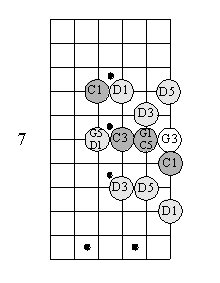
The diagram below shows where the nearest IV and V chords are found when playing the "V" shaped G chord at the 10th fret. The C chord is just up the neck from the G chord. The nearest D chord is just down the neck from the G, but there is another D up the neck.
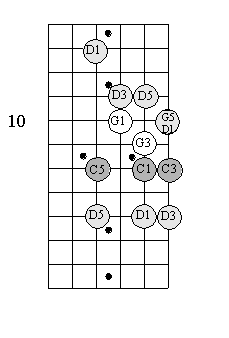
The diagram below shows where the nearest IV and V chords are found when playing the diagonal G chord at the 14th fret. The D chord overlaps the G chord. There is a C chord above and below the G chord.
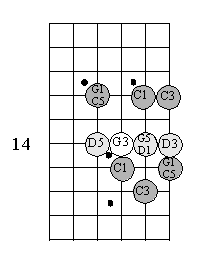
Step 3 - Navigating from the IV and V Chord
The third step is to turn this around and learn to navigate from the IV and V chords. For each of the three basic chord positions assume you're playing the IV chord and learn how to get to the I and V chords. Then assume you're playing the V chord and learn how to get to the I and IV chord. This is left this as an exercise for the reader.
Step 4 - Bass Strings
Most of the action occurs on the four treble strings. Eventually you need to learn the bass strings as well. The diagram below shows the three basic chord shapes for the bass strings. If you know the High or Low G tuning these shapes should be familiar. Do the same exercises to learn how to move to and from these positions.
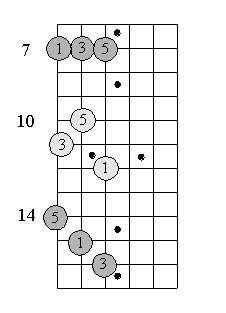
Conclusion
If you learn this information you'll be on your way to mastering the C6 tuning. Always be aware of how the note you're playing relates to the underlying chord.
This approach is just the first step. I've only looked at the I, IV and V chords. This works fine for many simple tunes. As you start playing more sophisticated music you'll need need to know minor, augmented and diminished chord shapes and well as four note chords such as maj7, min7, etc. However, if you learn this basic information well it is easy to extend it to other chord types.
I've written two other documents that may be useful for learning C6. One is an analysis of Harmonized Scales in C6. The other is a list of C6 Instructional Materials and Links.
Feel free to contact
me if you have any comments.
Updates:
04/11/05 - Initial version
04/03/06 - Moved to new server